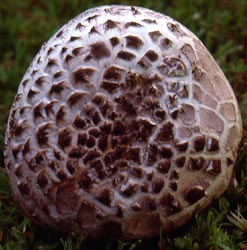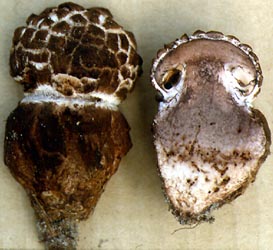[ Section Lepidella page. ]
[ Amanita Studies home. ]
[ Keys & Checklist/Picturebooks ]
[ E. Texas & Gulf Coast list ]
Amanita westii (Murrill) Murrill
"West's Lepidella"





Technical description (t.b.d.)
BRIEF DESCRIPTION: Amanita westii has a pileus densely set with pyramidal warts that are brown on the surface and white in the interior (at least in young material). The basidiocarp is prone to sordid reddish bruising and staining and has a slight odor of anise. Dried specimens take on the color of cocoa powder or a deep wine-red color somewhat like that of dried specimens of Leucoagaricus americanus (Peck) Vellinga.
The cap of A. westii is 70 - 155 mm wide, convex to plano-convex, eventually planar, subviscid to dry, pale reddish brown to pale chocolate brown. The context is up to 20 mm thick above the stipe, white quickly bruising reddish brown or near Prussian Red, then changing to Light Seal Brown, and eventually blackish; margin nonstriate, appendiculate with material hanging down 3 - 4 mm; universal veil as large warts, pyramidal to somewhat flattened (in the latter case often with a small central pimple), 2 - 4 mm high, with irregularly polygonal bases 3 - 5 x 8 - 10 mm, largest near pileus margin, densest over disk, near Light Seal Brown, removable.
The gills are adnexed by a line to the stipe apex at first, then seceding, sometimes remote at maturity, rather crowded to close to subdistant, white at first, then gray white, finally reddish brown, drying reddish brown to dark brown, 10 - 12 mm broad; the short gills are brief, in one or two tiers, with the shortest subtruncate to somewhat rounded subattenuate.
The stipe is 70 - 155 × 15 - 35 mm, more or less cylindric or constricted at about the mid-point, covered at first with floccose-fibrillose material which adheres to the fingers, densely floccose to floccose-subfelted in the apical region below the annulus, becoming undecorated, dry, originally whitish (sometimes becoming grayish) near apex, otherwise reddish brown or a very dark brown or pale reddish brown, concolorous with pileus in exsiccata; context white, with color changes on cutting or bruising as in the pileus, solid; the stipe's bulb is obovoid-napiform to napiform to turbinate to broadly fusiform, radicating, occasionally abrupt to subabrupt, up to 40 - 45+ × 30 - 50 mm, becoming colored like other parts; the annulus is apical, subfelted to felted-submembranous, fragile, detersile or adhering to edges of lamellae, white at first, then pale reddish brown, striate above, underside densely flocculose. The volva consists of fibrillose material (occasionally vague warts or felted patches) at the stipe base and on the upper half of the stipe's bulb in the “button” stage, easily removed, colored as on pileus.
The odor is faintly of anise according to Murrill. The taste is sweet and nutty at first, becoming slightly astringent according to Murrill.
The spores measure (8.5-) 10.5 - 13.9 (-15.5) x (5.0-) 6.0 - 7.8 (-8.2) µm and are ellipsoid to elongate (occasionally cylindric) and amyloid. Clamps are absent from bases of basidia
Amanita westii occurs in small groups in oak, oak-pine-beech, and oak-hickory forests.
The species is presently known only from Florida, Mississippi, and Texas, U.S.A. It should be expected in appropriate habitats along the US coast of the Gulf of Mexico.
As Dr. C. Bas proposed in his 1969 monograph on Amanita sect. Lepidella,
the closest phenetic relative of A. westii is A. sculpta Corner & Bas.
-- R. E. Tulloss and D. P. Lewis
Photos courtesy of Dr. Toby Feibelman (top left, Mississippi); David P. Lewis (top right, 2nd row left, 3rd row, and background tiling, eastern Texas); and Benjamin Wolfe (2nd row right, eastern Texas).
[ Section Lepidella page. ]
[ Amanita Studies home. ]
[ Keys & Checklist/Picturebooks ]
[ E. Texas & Gulf Coast list ]
Last change 22 March 2009.
This page is maintained by R. E. Tulloss.
Copyright 2002, 2003, 2004, 2007, 2009 by Rodham E. Tulloss.
Photograph copyright 2002 Dr. Toby Feibelman.
Photograph copyright 2003, 2007 David P. Lewis.
Photography copyright 2007 Benjamin Wolfe.